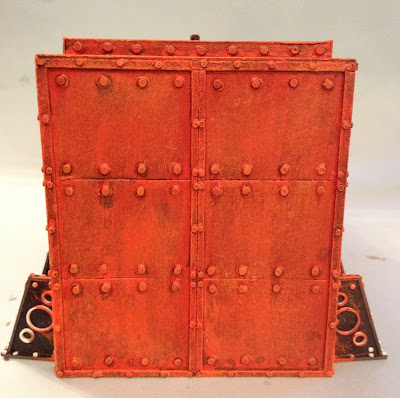 |
| Boiler and Furnace, together at last! |
It's a gorgeous, hot, sunny day. I've been swimming in the sea, enjoying the weather, and I've just got enough time to post a bit of a blog thingummy before pub time!
 |
| The finished boiler, resplendent in red, green and gold! I'm very happy with how this is looking. |
Since my last post, I've finished painting the boiler and have constructed and painted the furnace. Soon I'll be adding all sorts of other machine parts, completing the engine room and moving on to the next part of this gigantic project...
The furnace started life as a paint pot exactly like the one whose lid formed the front of the boiler. I did try constructing a square furnace from card but it wasn't quirky enough. So I started again. A minor problem posed by the paint pot was that the back of it had loads of raised writing. Fortunately, these pots are designed to stack, so by cutting up a spare lid, I was able to cover the back. All it took was a sharp knife and a steady hand.
 |
| The furnace is lined with foil to reflect the LEDs I'll build in later. A stand is made from plastic. Stand and paint pot have holes cut in the bottom so I can push the LEDs up inside later. |
I have decided to build lighting into the furnace, which will be tinted to be redder than the other LED lights around the rest of the vehicle. These will be inserted through holes in the bottom of the furnace later.
 |
| The furnace takes shape. This was built up using my patented 'stick bits on until it looks right' technique. I hereby give permission for you to adapt this method for your own projects. |
Slots were cut into the front of the furnace, through which the engineers can view the interior. These were glassed over with acetate, then a face was constructed around them with plastic board and the inevitable rivets...
 |
| The finished furnace, pre-painting. |
Push pins, thin card panels and other details were added as I thought of them. The four circular outlets will be used for something or other much later. Who knows at this stage? Not me!
 |
| Boiler and furnace are checked together. |
 |
| During painting. It looks kind of Soviet at this point... |
Painting was fast and simple. The whole thing started out black, but I added red, green and gold to tie it in with the boiler.
 |
| Painted and glorious! Lord Smudgington Smythely-Smythe looks on in admiration. I may add the date of the vehicle's commission to the gold plate. |
So: I suppose I should mention the Rivet Count!
The furnace has 155 rivets, bringing the total for the Engine Room to 1322...
And... The total for the walker so far:
2,252 !
Not bad, eh? Of course, there's a very long way to go! Next up: Chimneys!
 |
| Furnace and boiler together. Big, red and powerful. Just like The Empire, eh what! |
So that's it for now... I hear the pub calling to me!
All the Best!







































